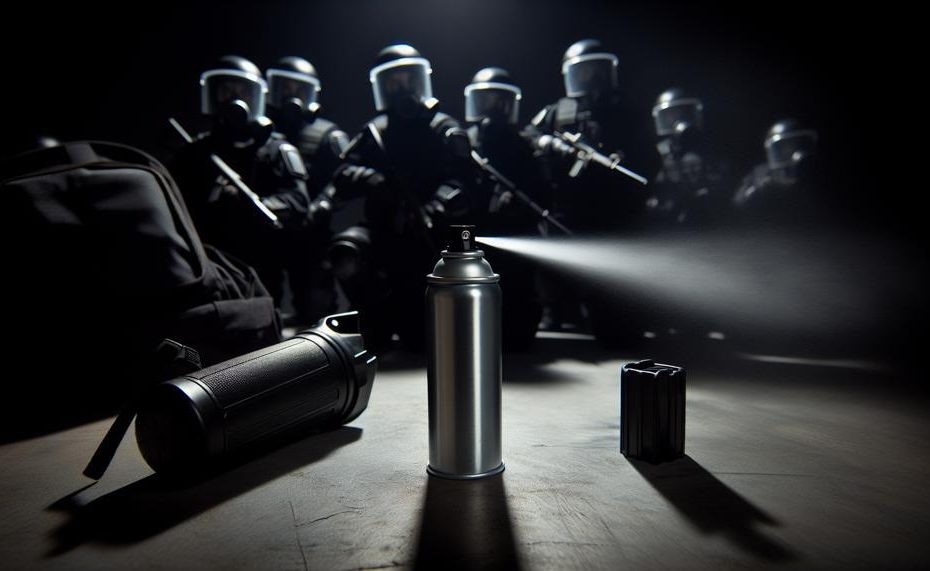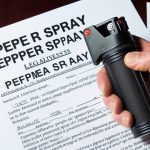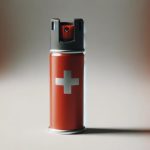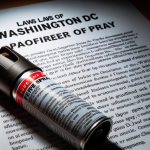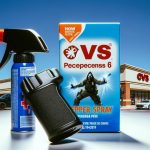Pepper spray and tear gas – two non-lethal self-defense weapons that have been making headlines recently. While they may seem interchangeable, there are actually significant differences between these two substances.
In this blog post, we will delve into the unique properties of pepper spray and tear gas to help you determine which one may be more suitable for your personal safety needs.
- Both pepper spray and tear gas are designed to temporarily incapacitate an attacker or crowd, but their effects differ greatly.
- Pepper spray is derived from a natural compound found in chili peppers, while tear gas is a synthetic chemical.
- The aftermath of pepper spray includes an intense burning sensation in the eyes, nose, and throat, while tear gas causes severe irritation to the eyes, skin, and respiratory system.
- Pepper spray is typically used for individual self-defense purposes, while tear gas is commonly deployed by law enforcement for crowd control.
- The legality of pepper spray varies by state, but tear gas is legal for civilians to possess in most states.
- Proper training and precautions should always be taken when handling either substance.
Now that we have outlined some key points about pepper spray and tear gas, let’s dive deeper into their differences and similarities. Whether you are looking for personal protection or simply interested in learning more about these non-lethal options, this comparison will provide valuable insights.
So, let’s start.
Contents
- 1 Pepper Spray Vs Tear Gas
- 2 Understanding the Effects of Pepper Spray and Tear Gas on the Body
- 3 Legalities Surrounding the Use of Pepper Spray and Tear Gas in Self-Defense
- 4 How to Choose the Right Pepper Spray for Your Needs
- 5 Comparing the Effectiveness of Pepper Spray and Tear Gas in Self-Defense Situations
- 6 Tips for Properly Using Pepper Spray and Tear Gas for Self-Defense
- 7 Potential Dangers and Risks Associated with Using Pepper Spray and Tear Gas
- 8 Conclusion
Pepper Spray Vs Tear Gas
Pepper spray and tear gas are two distinct tools used for self-defense, but their chemical composition, delivery mechanisms, and effects on the body are vastly different.
Chemical Composition
Pepper spray contains capsaicin, a natural chemical derived from chili peppers, and mainly affects the skin and eyes.
On the other hand, tear gas contains CS or CN, synthetic chemicals that impact the entire respiratory system, including the eyes, nose, throat, and lungs.
These differences in chemical makeup contribute to the varying levels of discomfort and disability caused by each spray.
Delivery Mechanisms
Aside from their chemical composition, pepper spray and tear gas also differ in how they are delivered.
Pepper spray is dispensed through a small canister with a nozzle that sprays a stream or mist directly onto the target.
In contrast, tear gas is released through a smoke grenade or canister that releases a cloud of gas into the air.
This distinction in delivery methods can also affect the level of exposure and severity of the effects.
Effects
While both pepper spray and tear gas can cause temporary discomfort and disability, tear gas has been heavily criticized for its potential to cause severe injuries and even deaths.
Tear gas is known to cause severe coughing, choking, and respiratory distress if inhaled in high concentrations. In comparison, pepper spray can cause temporary blindness and difficulty breathing if inhaled.
It is crucial to understand these differences between pepper spray and tear gas and use them responsibly.
While both can be effective tools for self-defense in certain situations, it is essential to use them with caution and only when necessary.
Moreover, it is crucial to follow proper safety protocols when handling these sprays to avoid any accidental harm.
Understanding the Effects of Pepper Spray and Tear Gas on the Body
Pepper spray and tear gas are commonly used for crowd control or self-defense purposes. However, these chemical agents can have significant impacts on the body and pose potential health risks.
Here, we will delve into how pepper spray and tear gas affect the body, and discuss some of the potential health hazards associated with their use.
Effects of Pepper Spray on the Body:
Derived from a chili plant, pepper spray is a chemical agent that is typically sprayed directly onto an individual’s face or skin. When exposed, it causes intense pain, coughing, and temporary blindness.
This is because of its active ingredient, capsaicin, which creates a burning sensation on the skin and irritates the respiratory system when inhaled. The effects of pepper spray usually kick in within seconds of exposure and can last up to an hour.
Potential Health Risks Associated with Pepper Spray:
While pepper spray is generally considered non-lethal, it can lead to serious health complications, especially in individuals with underlying heart or lung conditions. For instance, people with asthma or COPD may experience severe respiratory distress when exposed to pepper spray.
Additionally, exposure to pepper spray can cause irritation and inflammation of the lining of the lungs and upper airway, resulting in wheezing, coughing, and choking.
Effects of Tear Gas on the Body:
In contrast, tear gas is a synthetic chemical often used for riot control or military purposes. It is usually delivered in the form of smoke grenades that release a cloud of gas into the air.
When inhaled, tear gas irritates the mucous membranes of the eyes, nose, throat, and lungs, causing intense burning sensations and difficulty breathing. The effects of tear gas can also linger for up to an hour.
Potential Health Risks Associated with Tear Gas:
The use of tear gas can have severe health consequences, especially in enclosed spaces or on individuals with pre-existing health conditions.
Exposure to tear gas can result in pulmonary, cutaneous, and ocular problems, such as bronchospasm, skin burns, and corneal injury.
In severe cases, it can also lead to respiratory failure, chemical pneumonitis, and permanent vision loss.
Legalities Surrounding the Use of Pepper Spray and Tear Gas in Self-Defense
Legalities
Laws and regulations governing the use of pepper spray and tear gas for self-defense purposes differ depending on the jurisdiction.
Generally, federal and state laws regulate the purchase, possession, and use of these substances, making it essential to have a thorough understanding of these laws for responsible and legal use.
Moreover, law enforcement agencies have their own guidelines for the use of these substances in situations of riot control.
It is imperative to consider these substances as a last resort in self-defense scenarios and to abide by the laws and regulations to avoid potential legal repercussions.
Self-Defense
Self-defense is a fundamental human right, and it is crucial to know and understand the legalities surrounding it. For instance, in some countries, civilians are not allowed to carry pepper spray or tear gas unless they have a valid permit.
In such cases, it is vital to comply with these regulations to avoid facing charges for illegal possession.
In addition, there are certain restrictions on the strength and amount of pepper spray or tear gas that can be carried or used for self-defense. These limitations aim to prevent excessive harm and ensure responsible usage of these substances.
How to Choose the Right Pepper Spray for Your Needs
Deciding on the right self-defense option between pepper spray and tear gas involves considering several important factors.
These include the active ingredients, effectiveness, range and coverage, legal implications, and personal tolerance.
Active Ingredients:
Pepper spray is derived from capsaicin, a chemical found in hot peppers, while tear gas may contain one of three chemicals – chloroacetophenone (CN), chlorobenzylidenemalononitrile (CS), or dibenzoxazepine (CR).
Understanding the active ingredients in each option can help determine which is more suitable for your specific needs.
Effectiveness:
Both pepper spray and tear gas can be effective in disabling an attacker, but their effects differ. Pepper spray immediately causes intense burning sensations, making it difficult for an attacker to continue their assault.
On the other hand, tear gas may take longer to take effect but can affect a wider area, not just the immediate target.
Range and Coverage:
Pepper spray typically has a range of 6-12 feet, while tear gas can reach up to 30 feet. This can be a crucial factor in situations where an attacker is further away or if there are multiple attackers.
However, it is important to note that tear gas can also have a wider coverage, affecting a larger area.
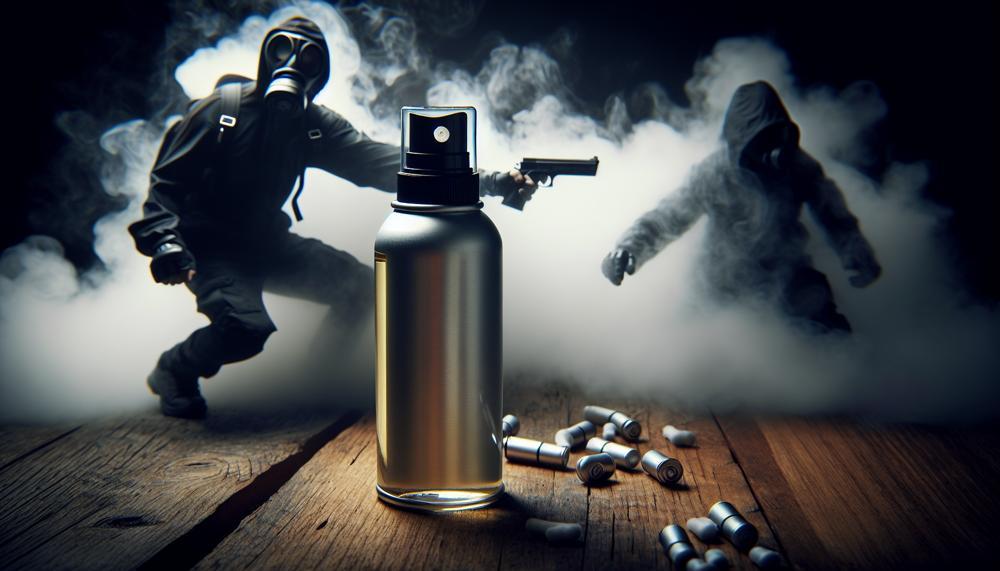
Legal Implications:
It is crucial to be aware of the legal implications of using pepper spray or tear gas as a self-defense option.
While pepper spray is legal in all 50 states with varying restrictions on its size and strength, tear gas may be illegal in certain states or require a special permit.
It is important to research and understand the laws in your state before purchasing and using either option.
Personal Tolerance:
Personal tolerance is also an important factor to consider when choosing between pepper spray and tear gas. Some individuals may have a higher tolerance for one over the other, making it more effective for them as a self-defense option.
It is recommended to test both options in a controlled environment before carrying them for personal protection.
Comparing the Effectiveness of Pepper Spray and Tear Gas in Self-Defense Situations
When it comes to protecting oneself, the use of non-lethal self-defense tools such as pepper spray and tear gas has become increasingly popular. However, many people are unsure about which option is more effective in a self-defense situation.
Here, we will compare the chemical makeup, intended use, and level of pain/discomfort caused by pepper spray and tear gas to determine their effectiveness.
| Chemical Composition | Pepper spray is made from capsaicin, derived from a chili plant, while tear gas is a man-made compound consisting of various chemicals. |
| Intended Purpose | Pepper spray is designed specifically for self-defense, while tear gas is primarily used for crowd control by law enforcement and military personnel. |
| Level of Discomfort | Upon contact, pepper spray causes intense pain and temporary blindness, while tear gas causes severe irritation but does not have an immediate effect. |
Tips for Properly Using Pepper Spray and Tear Gas for Self-Defense
When deciding to use pepper spray or tear gas for self-defense, it is vital to take all necessary safety measures to avoid causing harm to yourself or others. Below are some crucial tips that you must always keep in mind:
- Familiarize yourself with the product: Before carrying or using pepper spray, ensure that you understand its safety features and how to aim and spray it properly. This will enable you to use it effectively in case of an emergency.
- Use it only in times of imminent danger: Never use pepper spray as a toy or for any other purpose than self-defense. It should only be used as a last resort when facing an assailant or aggressive animal.
- Seek help and create an opportunity to escape: After using pepper spray, seek assistance from authorities and create a chance to escape the situation. Do not stay near the attacker as they may still pose a threat.
- Understand the laws: It is crucial to have a clear understanding of the laws regarding carrying and using pepper spray in your state or country. Some places have limitations on the size or type of pepper spray allowed, while others may require a permit.
- Practice proper usage: To ensure that you can use pepper spray effectively, practice using it beforehand. This will also help you become familiar with its range and how to aim for the attacker’s face.
- Avoid contact with skin and eyes: Pepper spray can cause severe irritation if it comes into contact with the skin or eyes. Make sure to avoid spraying it in windy situations and wash your hands thoroughly after use.
- Check expiration dates and store properly: Regularly check the expiration date of your pepper spray and test sprays to ensure its effectiveness. Store it in a cool, dry place as exposure to heat and sunlight can decrease its potency.
- Understand its limitations: While pepper spray can deter aggressive animals, it may not be effective if expired. It also has a limited range and may not work on individuals who are under the influence of drugs or alcohol.
- Follow airline regulations: Pepper spray is not permitted in carry-on luggage, but it may be allowed in checked bags. Make sure to check with the airline before traveling.
Potential Dangers and Risks Associated with Using Pepper Spray and Tear Gas
Pepper spray and tear gas are commonly used for self-defense, but it is crucial to understand the potential dangers and risks that come with their usage. These substances not only pose a threat to the attacker but also to the person using them and innocent bystanders.
From physical reactions to long-term health consequences, psychological effects, and harm to others, there are many factors to consider before relying on pepper spray or tear gas for self-defense.
Physical Reactions
Pepper spray and tear gas are classified as chemical irritants, designed to cause intense pain and discomfort in the attacker’s eyes, skin, and respiratory system. However, if not used carefully, these substances can also have adverse effects on the person using them.
Exposure to these chemicals can trigger severe allergic reactions, respiratory distress, and even cardiac arrest.
Long-Term Health Consequences
Studies have shown that repeated exposure to pepper spray and tear gas can lead to long-term health consequences, especially on the respiratory system. These chemicals have been found to cause damage to the lungs and increase the risk of developing chronic respiratory problems.
This makes them particularly dangerous for individuals with pre-existing health conditions.
Psychological Effects
The intense pain and discomfort caused by pepper spray and tear gas can also have psychological effects on both the attacker and the person using them.
These substances can trigger panic attacks, anxiety, and trauma in some individuals, which can have long-lasting effects on their mental well-being.
Harm to Others
One of the biggest risks associated with using pepper spray and tear gas for self-defense is the potential harm it can cause to innocent bystanders.
These substances are often dispersed in aerosol form, making it easy for them to spread and affect anyone in close proximity.
This can be especially dangerous for individuals with pre-existing health conditions or children.
Conclusion
In conclusion, pepper spray and tear gas are two non-lethal self-defense options with distinct chemical compositions, intended uses, and levels of discomfort.
While they can effectively incapacitate an attacker or control a crowd, it is crucial to recognize the potential dangers and risks associated with their use. Proper training, knowledge of laws and regulations, and responsible handling are vital for ensuring personal safety as well as the safety of others.
So always exercise caution and adhere to safety protocols when handling pepper spray or tear gas for self-defense purposes.
